Articles
- Page Path
- HOME > J Korean Acad Nurs > Volume 44(2); 2014 > Article
-
Original Article
- Development and Validity of Workplace Bullying in Nursing-Type Inventory (WPBN-TI)
- Younju Lee, Mihyoung Lee
-
Journal of Korean Academy of Nursing 2014;44(2):209-218.
DOI: https://doi.org/10.4040/jkan.2014.44.2.209
Published online: April 30, 2014
1Department of Nursing, JEI University, Incheon, Korea.
2Department of Nursing, Inha University, Incheon, Korea.
- Address reprint requests to: Lee, Mihyoung. Department of Nursing, Inha University, 100 Inha-ro, Nam-gu, Incheon 402-751, Korea. Tel: +82-32-860-8205, Fax: +82-32-874-5880, mihyoung@inha.ac.kr
© 2014 Korean Society of Nursing Science
This is an Open Access article distributed under the terms of the Creative Commons Attribution NoDerivs License. (http://creativecommons.org/licenses/by-nd/4.0/) If the original work is properly cited and retained without any modification or reproduction, it can be used and re-distributed in any format and medium.
Abstract
-
Purpose
- The purpose of this study was to develop an instrument to assess bullying of nurses, and test the validity and reliability of the instrument.
-
Methods
- The initial thirty items of WPBN-TI were identified through a review of the literature on types bullying related to nursing and in-depth interviews with 14 nurses who experienced bullying at work. Sixteen items were developed through 2 content validity tests by 9 experts and 10 nurses. The final WPBN-TI instrument was evaluated by 458 nurses from five general hospitals in the Incheon metropolitan area. SPSS 18.0 program was used to assess the instrument based on internal consistency reliability, construct validity, and criterion validity.
-
Results
- WPBN-TI consisted of 16 items with three distinct factors (verbal and nonverbal bullying, work-related bullying, and external threats), which explained 60.3% of the total variance. The convergent validity and determinant validity for WPBN-TI were 100.0%, 89.7%, respectively. Known-groups validity of WPBN-TI was proven through the mean difference between subjective perception of bullying. The satisfied criterion validity for WPBN-TI was more than .70. The reliability of WPBN-TI was Cronbach's α of .91.
-
Conclusions
- WPBN-TI with high validity and reliability is suitable to determine types of bullying in nursing workplace.
This manuscript is a based on a part of the first author's doctoral dissertation from Inha University.
This work was supported by INHA University Research Grant.
- 1. Pearson CM, Andersson LM, Porath CL. Workplace incivility. In: Fox S, Spector PE, editors. Counterproductive work behavior: Investigations of actors and targets. Washington, DC: American Psychological Association; 2004. p. 177–200.
- 2. Rutherford A, Rissel C. A survey of workplace bullying in a health sector organisation. Aust Health Rev. 2004;28(1):65–72.ArticlePubMed
- 3. Abe K, Henly SJ. Bullying (ijime) among Japanese hospital nurses: Modeling responses to the revised negative acts questionnaire. Nurs Res. 2010;59(2):110–118. http://dx.doi.org/10.1097/NNR.0b013e3181d1a709PubMed
- 4. Berry PA, Gillespie GL, Gates D, Schafer J. Novice nurse productivity following workplace bullying. J Nurs Scholarsh. 2012;44(1):80–87. http://dx.doi.org/10.1111/j.1547-5069.2011.01436.xArticlePubMed
- 5. Nam W, Kim JW, Kim YK, Koo JW, Park CY. The reliability and validity of the negative acts questionnaire-revised (NAQ-R) for nurses for the assessment of workplace bullying. Korean J Occup Environ Med. 2010;22(2):129–139.ArticlePDF
- 6. Park KO, Kim SY, Kim JK. Hospital nurses' experience of bullying in the workplace and burnout, organizational commitment, turnover intention and nursing productivity. J Korean Clin Nurs Res. 2013;19(2):169–180.
- 7. Lee Y, Lee M, Bernstein K. Effect of workplace bullying and job stress on turnover intention in hospital nurses. J Korean Acad Psychiatr Ment Health Nurs. 2013;22(2):77–87. http://dx.doi.org/10.12934/jkpmhn.2013.22.2.77Article
- 8. Vessey JA, Demarco R, DiFazio R. Bullying, harassment, and horizontal violence in the nursing workforce: The state of the science. Annu Rev Nurs Res. 2010;28:133–157.ArticlePubMed
- 9. Einarsen S, Hoel H, Notelaers G. Measuring exposure to bullying and harassment at work: Validity, factor structure and psychometric properties of the negative acts questionnaire-revised. Work Stress. 2009;23(1):24–44. http://dx.doi.org/10.1080/02678370902815673Article
- 10. Losa Iglesias ME, Becerro de Bengoa Vallejo R. Prevalence of bullying at work and its association with self-esteem scores in a Spanish nurse sample. Contemp Nurse. 2012;42(1):2–10. http://dx.doi.org/10.5172/conu.2012.42.1.2ArticlePubMed
- 11. Jacobson KJL, Hood JN, Van Buren III HJ. Workplace bullying across cultures: A research agenda. Int J Cross Cult Manag. 2014;14(1):47–65. http://dx.doi.org/10.1177/1470595813494192
- 12. Kim MS. Role of self-leadership in the relationship between organizational culture and informatics competency. J Korean Acad Nurs. 2009;39(5):731–740. http://dx.doi.org/10.4040/jkan.2009.39.5.731ArticlePubMed
- 13. Min S, Kim HS. Correlation between perception of nurses about transformational leadership and nursing performance. Daehan J Bus. 2005;18(2):871–885.
- 14. Kang H. A guide on the use of factor analysis in the assessment of construct validity. J Korean Acad Nurs. 2013;43(5):587–594. http://dx.doi.org/10.4040/jkan.2013.43.5.587ArticlePubMed
- 15. Waschgler K, Ruiz-Hernández JA, Llor-Esteban B, Jiménez-Barbero JA. Vertical and lateral workplace bullying in nursing: Development of the hospital aggressive behaviour scale. J Interpers Violence. 2013;28(12):2389–2412. http://dx.doi.org/10.1177/0886260513479027ArticlePubMedPDF
- 16. Lee YJ, Bernstein K, Lee M, Nokes KM. Bullying in nursing workplace: Applying evidence using a conceptual framework. Nurs Econ. 2014;Forthcoming.PMC
- 17. Lee Y. The conceptual development and development of new instruments to measure bullying in nursing workplace [dissertation]. Incheon, Inha University. 2014.
- 18. Park HS. Behavior and attitude on pilot Korean-DRG system among doctors and nurses [master's thesis]. Busan, Inje University. 2002.
- 19. Lynn MR. Determination and quantification of content validity. Nurs Res. 1986;35(6):382–385.ArticlePubMed
- 20. Williams B, Brown T, Onsman A. Exploratory factor analysis: A five-step guide for novices. J Emerg Prim Health Care. 2010;8(3):Article 990399. ArticlePDF
- 21. Han SS, Lee SC. SPSS nursing and health statistical analysis. Seoul: Hyunmoon; 2006.
- 22. Ware JE, Snow KK, Kosinski M, Gandek B. SF-36 health survey: Manual and institute. Boston, MA: The Health Institute, New England Medical Center; 1993.
- 23. Cho YH, Hong YR, Lee AM, Kim MK, Lee HJ, Han AK, et al. Experience of verbal abuse, emotional response, and ways to deal with verbal abuse against nurses in hospital. Korean J Occup Health Nurs. 2011;20(3):270–278. http://dx.doi.org/10.5807/kjohn.2011.20.3.270Article
- 24. Lee SH, Chung SE. Nurses's experience of verbal violence in hospital setting. J Korean Acad Nurs Adm. 2007;13(4):526–536.
- 25. Seo YN, Leather P, Coyne I. South Korean culture and history: The implications for workplace bullying. Aggress Violent Behav. 2012;17(5):419–422. http://dx.doi.org/10.1016/j.avb.2012.05.003Article
- 26. Johnson SL. International perspectives on workplace bullying among nurses: A review. Int Nurs Rev. 2009;56(1):34–40. http://dx.doi.org/10.1111/j.1466-7657.2008.00679.xArticlePubMed
- 27. Han KS, Choi MY, Lee SJ. Experiences of job stress-coping in health care professionals. Korean J Stress Res. 2013;21(2):131–139.
- 28. Hutchinson M, Wilkes L, Vickers M, Jackson D. The development and validation of a bullying inventory for the nursing workplace. Nurse Res. 2008;15(2):19–29. http://dx.doi.org/10.7748/nr2008.01.15.2.19.c6326ArticlePubMed
- 29. Einarsen S, Hoel H, Zapf D, Cooper CL. The concept of bullying and harassment at work: The European tradition. In: Einarsen S, Hoel H, Zapf D, Cooper CL, editors. Bullying and harassment in the workplace: Developments in theory, research, and practice. 2nd ed. Boca Raton, FL: CRC Press; 2011. p. 3–39.
- 30. Hair JF, Anderson RE, Tatham RL, Black WC. Multivariate data analysis: With readings. 3rd ed. New York, NY: Macmillan Pulishing Company; 1992.
REFERENCES
Figure & Data
REFERENCES
Citations

- The impact of workplace bullying on depression among clinical nurses in China: A comparative analysis
Jiao-Zhi Zhou, Xin Liu, Gong-Jie Ye
Medicine.2025; 104(2): e41246. CrossRef - Resilience as mediator and moderator in witnessing workplace bullying and professional identity
Yeoungsuk Song, Yoonmi Lee, Junghoon Lee
Advances in Health Sciences Education.2025;[Epub] CrossRef - Examining the role of self-conscious emotions and perfectionistic self-presentation in workplace bullying among Korean nurses: a cross-sectional study
Sun Joo Jang, Haeyoung Lee, Sophia J. Chung
BMC Nursing.2025;[Epub] CrossRef - Organizational Silence and Related Factors Among Shift Work Nurses in Korea: A Cross‐Sectional Study
Sung Eon Sim, Hye-Young Jang, De-Chih Lee
Journal of Nursing Management.2025;[Epub] CrossRef - Impact of workplace violence on depression among workers: A focus on gender differences
Jiseon Kim
Korean Journal of Health Education and Promotion.2024; 41(3): 61. CrossRef - Workplace Bullying, Hardiness, and Occupational Identity Among Nursing Students: Mediation of Academic Burnout
KyungJa Kang, Mi Yu
Journal of Nursing Education.2024; 63(9): 604. CrossRef - When Does the Reproduction of Violence Begin? The Effects of Indirect Violence during Clinical Training on Career Identity
Eun-Hi Choi, Ji-yeon Kim, Sookbin Im, Susanna Kim, Seoyeon Park, Haein Song, Daeun Lee, Seunghyun Lee, Jieun Lee, Yebin Cho
Sage Open.2024;[Epub] CrossRef - Bullying against Healthcare Professionals and Coping Strategies: A Scoping Review
Ana Rita Valente Ribeiro, Ana Isabel Sani
International Journal of Environmental Research and Public Health.2024; 21(4): 459. CrossRef - Effects of Organizational Silence and Organizational Justice on Bullying among Hospital Nurses at Work
Mi-Aei Lee, Bi-Joo Kim
Journal of Korean Academy of Nursing Administration.2023; 29(1): 1. CrossRef - The Influence of Nurses’ Workplace Bullying, Social Interaction Anxiety and Positive Psychological Capital on Nursing Performance
Hyang Mi Kim, Sun Hee Jang
Journal of Korean Academy of Nursing Administration.2023; 29(3): 331. CrossRef - Relationship between Ethical Climate, Workplace Bullying, and Turnover Intention of Hospital Nurses in Korea
Mi-Aie Lee, Hyun Ju Park, Bonghwa Kim
Journal of Korean Academy of Nursing Administration.2023; 29(4): 457. CrossRef - Workplace bullying and different levels of post‐traumatic stress symptoms of nurses: A quantile regression approach for effective coping strategies
Soyun Hong, Heejung Kim, Eun Kyoung Choi, Chang Gi Park
Journal of Nursing Management.2022; 30(6): 1445. CrossRef - Impact of workplace bullying and resilience on new nurses' turnover intention in tertiary hospitals
Gyu Li Baek, EunJu Lee
Nursing & Health Sciences.2022; 24(4): 801. CrossRef - Structural Equation Modeling on Workplace Incivility of Nurses: Evolution to Bullying
Seo In Kim, Soukyoung Kim
Journal of Korean Academy of Nursing Administration.2022; 28(4): 406. CrossRef - Structural Model of Retention Intention of Nurses in Small- and Medium-Sized Hospitals: Based on Herzberg’s Motivation-Hygiene Theory
Joo Yeon Lee, Mi Hyang Lee
Healthcare.2022; 10(3): 502. CrossRef - Effects of Clinical Nurses’ Workplace Bullying, Empathic Ability, and Resilience on Job Satisfaction
Mi Young Lee, Youngrye Park
Journal of Korean Critical Care Nursing.2021; 14(2): 57. CrossRef - Effects of Workplace Bullying and Empowerment on Nurses' Turnover Intention
Yesul Lee, Yoonju Lee, Ju-Young Ha, Minjeong Jo
Journal of Korean Academy of Nursing Administration.2021; 27(1): 1. CrossRef - The Association between Korean Clinical Nurses’ Workplace Bullying, Positive Psychological Capital, and Social Support on Burnout
Seong-Ryeol Bae, Hyon-Joo Hong, Jin-Joo Chang, Sung-Hee Shin
International Journal of Environmental Research and Public Health.2021; 18(21): 11583. CrossRef - Influences of Workplace Bullying and Job Satisfaction on Happiness among Perioperative Nurses
Song I Park, Key Ha Kim
Journal of Korean Academy of Nursing Administration.2021; 27(1): 54. CrossRef - Measuring workplace violence for clinical dental hygienists
Seung‐Eun Won, Ma‐I Choi, Hiejin Noh, Sun‐Young Han, So‐Jung Mun
International Journal of Dental Hygiene.2021; 19(3): 340. CrossRef - Moderating Effects of Structural Empowerment and Resilience in the Relationship between Nurses’ Workplace Bullying and Work Outcomes: A Cross-Sectional Correlational Study
Heiyoung Kang, Kihye Han
International Journal of Environmental Research and Public Health.2021; 18(4): 1431. CrossRef - Reliability and Validity of the Bullying Measurement in Korean Nurses' Workplace
Hyo-Suk Song, So-Hee Lim
Journal of Korean Academy of Nursing Administration.2020; 26(5): 478. CrossRef - Nurses’ Workplace Bullying Experiences, Responses, and Ways of Coping
Sun Yee Yoo, Hye Young Ahn
International Journal of Environmental Research and Public Health.2020; 17(19): 7052. CrossRef - Effect of Job Stress, Working Bullying, Self-Efficacy on the Professional Self-Concept of Intensive Care Unit Nurses
Sang Min Oh, Sang Hee Kim
Journal of Korean Critical Care Nursing.2020; 13(2): 60. CrossRef - Comparative psychometric review of the Negative Acts Questionnaire-Revised in a unionized U.S. public sector workforce
Mazen El Ghaziri, Carla L. Storr, Shellie R. Simons, Alison M. Trinkoff, Kathleen M. McPhaul, Matthew London, Jeffrey V. Johnson, Jane Lipscomb
Work.2019; 62(1): 161. CrossRef - The Influence of Lateral Violence on Burnout and Empathy with Patients among Nurses: The Moderating Effect of Communication
Soohyun Nam, Boyoung Hwang
Stress.2019; 27(3): 224. CrossRef - Response Patterns of Nursing Unit Managers regarding Workplace Bullying: A Q Methodology Approach
Jin Kyu Choi, Byoungsook Lee
Journal of Korean Academy of Nursing.2019; 49(5): 562. CrossRef - Effects of nursing organisational culture on face‐to‐face bullying and cyberbullying in the workplace
JeongSil Choi, Mijeong Park
Journal of Clinical Nursing.2019; 28(13-14): 2577. CrossRef - Moderating effects of Professional Self-concept in Relationship between Workplace Bullying and Nursing Service Quality among Hospital Nurses
Eun Mi Lee, Duck Hee Kim
Journal of Korean Academy of Nursing Administration.2018; 24(5): 375. CrossRef - Relationships among Self-esteem, Social Support, Nursing Organizational Culture, Experience of Workplace Bullying, and Consequence of Workplace Bullying in Hospital Nurses
Eun-Hye Han, Yeongmi Ha
Journal of Korean Academy of Nursing Administration.2016; 22(3): 303. CrossRef - Reliability and validity of the workplace harassment questionnaire for Korean finance and service workers
Myeongjun Lee, Hyunjung Kim, Donghee Shin, Sangyun Lee
Annals of Occupational and Environmental Medicine.2016;[Epub] CrossRef - Qualitative Research on Nurses Experiencing Taeoom
SunHwa Choeng, InSook Lee
Korean Journal of Occupational Health Nursing.2016; 25(3): 238. CrossRef - Awareness and Attitudes Towards Violence and Abuse among Emergency Nurses
Ok-Hee Cho, Kyeong-Sook Cha, Yang-Sook Yoo
Asian Nursing Research.2015; 9(3): 213. CrossRef - Construct Validity of the Life Transition Scale for Parents of Children with Autism
Ae Ran Lee, Sun Woo Hong, Se Jin Ju
Journal of Korean Academy of Nursing.2014; 44(5): 563. CrossRef
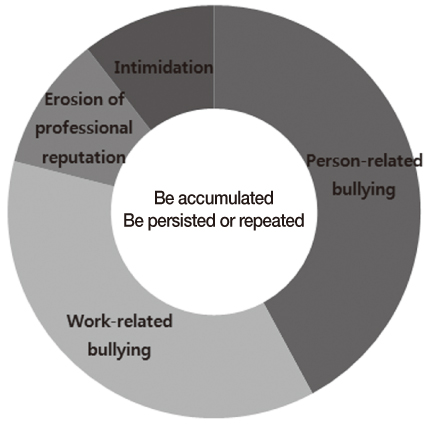
Figure 1
Demographic Characteristics of Participants (N=458)
ICU=Intensive care unit; ER=Emergency room; OR=Operating room; OPD=Outpatient department.
Rotated Factor Pattern Matrix and Communality of WPBN-TI
WPBN-TI=Workplace bullying in nursing-type inventory.
Multitrait/Multi-item Matrix of WPBN-TI (Correlation Matrix Corrected for Overlap)
WPBN-TI=Workplace bullying in nursing-type inventory.
Difference between Subjective Workplace Bullying Victimization and WPBN-TI
WPBN-TI=Workplace bullying in nursing-type inventory; SWPBV=Subjective workplace bullying victimization.
Correlations between the WPBN-TI and NAQ-R
WPBN-TI=Workplace bullying in nursing-type inventory; NAQ-R=Negative acts questionnaire-revised.
ICU=Intensive care unit; ER=Emergency room; OR=Operating room; OPD=Outpatient department.
WPBN-TI=Workplace bullying in nursing-type inventory.
WPBN-TI=Workplace bullying in nursing-type inventory.
WPBN-TI=Workplace bullying in nursing-type inventory; SWPBV=Subjective workplace bullying victimization.
WPBN-TI=Workplace bullying in nursing-type inventory; NAQ-R=Negative acts questionnaire-revised.
 KSNS
KSNS
 E-SUBMISSION
E-SUBMISSION

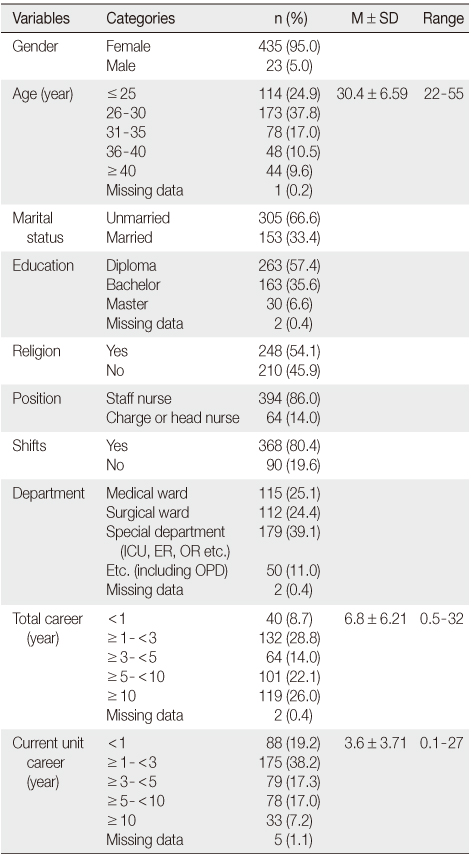
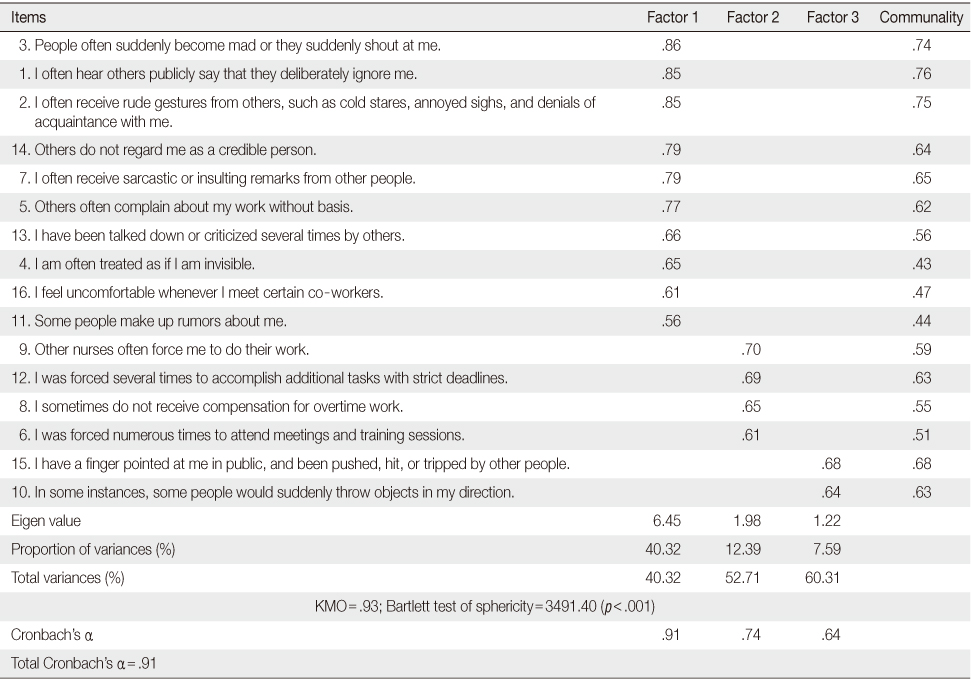
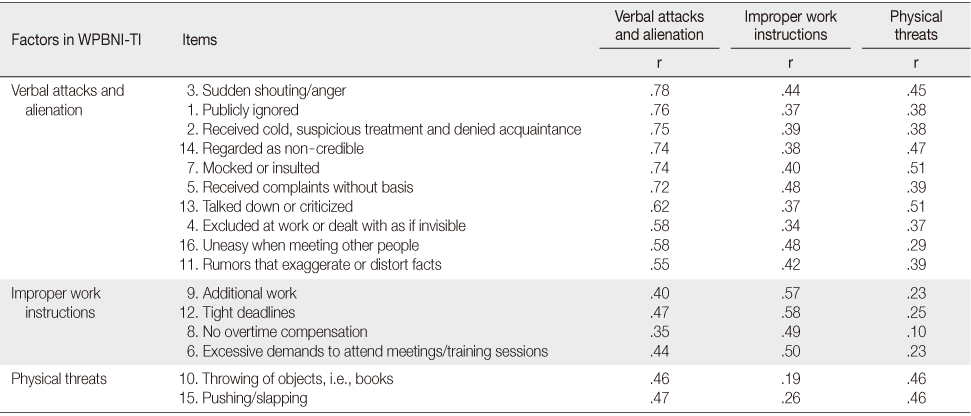
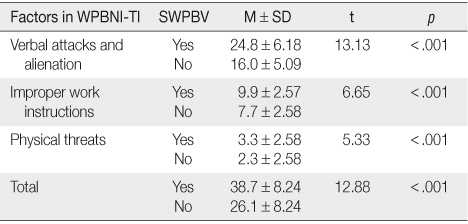
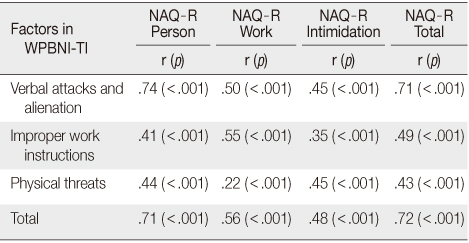
 Cite
Cite

